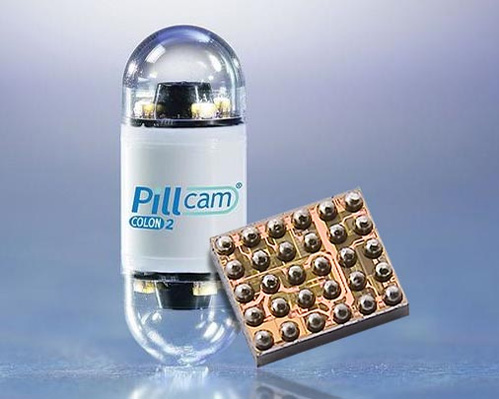Spectrum for life
Medical implants - a reality for millions
Mention the term 'electronic implant', and some may recall the frightening episode of cult 90s science-fiction series “The X-Files”, where Agent Scully is abducted by aliens and only realises some time later, after her return to (what was portrayed as) the real world, that she had acquired an implanted electronic chip in her neck. Thankfully, our reality is that similar earthly devices, 'active medical implants', do immense good.
About 7 million Europeans are subject to some form of heart failure, with about 600,000 new cases diagnosed each year. About one half of these can benefit from having implantable cardiac devices fitted. These devices uniquely deliver round-the-clock therapy that is needed to preserve and enhance the quality of life for those affected.
Less dramatic, but even more serious for some people, is diabetes. The International Diabetic Foundation estimates that about 32 million Europeans have the condition. These people (and especially the 1.6 million with Type 1 diabetes) could greatly benefit from glucose monitoring and insulin delivery systems which can be implanted into the body and which mimic the human pancreas by essentially delivering insulin 'on demand'.
These are just two examples. There are estimated to be more than 10 million European patients with some form of active medical implant in their body that makes use of these wireless medical applications.
What are they?
The devices implanted to the body typically do something active such as assisting the heart or partly replacing the pancreas function in the above examples. They also need to monitor what is going on (diagnostic data). So they are supported by external devices ('peripherals') which support their operation by providing a means for altering the programming of the implanted device, or retrieving medically related diagnostic data from the implant, or transferring data to a mass storage system for review by the doctor. These are Medical Implant Communication Devices: 'MICS systems'.
To take the example of the heart patients, MICS technology in the 401 MHz to 406 MHz band is utilised in cardiac devices such as pacemakers that control the rhythm of heart contractions, defibrillators that recognise an abnormally high heart rate and deliver a high-energy pulse to restore a more natural rhythm, and combination devices that can do both. The 401 MHz to 406 MHz band is used for initial programming of the Ultra-Low-Power-Active-Medical-Implants (ULP-AMI), transferring diagnostic information from the ULP-AMI, and monitoring in the patient's home.
Applications of medical implants
In addition to the Cardiac Rhythm applications, there are other applications which can use the same technology. Some are already in place and some are under development, exploiting new sensor technology. Examples are given below, with an indication of the type of data traffic they generate.
- Neurological stimulator implants to control otherwise uncontrollable reflex muscular reactions from diseases such as Parkinson's and other brain disorders. This can also play a role in treating incontinence and pain. Deep Brain Stimulation (DBS) is an example of this type of implant, with devices having periods of relatively high duty cycle operation.
- Data collection systems. Portable devices for recording diagnostic data sent from an implant. Heart patients such as those who have experienced recent periods of arrhythmia could wear these devices.
- Body-worn sensor(s) communicating to an implanted device for the treatment of neurological disorders. These systems may require continuous or near continuous telemetry operation.
- Medical systems to diagnose and treat a wide variety of medical conditions (diabetes, gastrointestinal disorders, neurological conditions) that utilise implanted sensors and peripheral devices. This includes cameras that can be swallowed to take pictures of the inside of the intestines. These systems will have a range of operating scenarios with widely varying duty cycles.
Another application for ULP-AMI is membrane medical implants for registering blood pressure data. These operate in the frequency range from 30 MHz to 37.5 MHz, again to link the implanted device with the monitor.
What are we doing?
As with most uses of spectrum, frequency harmonisation is an important pre-requisite for wireless medical applications, primarily for interoperability. The frequencies for wireless medical implant communication systems in the CEPT area are identified in ERC Recommendation 70-03 Annex 12, and so are regularly reviewed by the Short Range Devices Maintenance Group (SRD-MG) of the ECC's Frequency Management Working Group (WG FM).
Currently, the SRD-MG is working on two subjects in the medical wireless application field:
- to draft and propose to WGFM a revision of ECC Decision ECC/DEC/(01)17 with the aim to put ULP-AMI operating in the band 401-406 MHz directly under the mobile service. This is in line with the worldwide situation for medical implant communication devices in other ITU-R regions. This will only affect potential future proposals for other SRD applications for operation in this frequency band. It will not affect the existing radio services and applications in the band.
- a proposal to designate the whole or part of the band 2360-2400 MHz to MBANS (Medical Body Area Network Systems) to be used in hospitals, at home, or by ambulances. A regulation in the USA from the Federal Communications Commission (FCC) is also under development with a new proposed regulation for the same frequency range. MBANS consist of sensors on and around the body that communicate medical data wirelessly for applications such as professional wireless patient monitoring.
These life-saving devices play a pivotal role in improving the lives of millions of Europeans and emphasise the importance of providing space for future technological advancements in a complex spectrum environment.
X-ray picture of an implanted heart pacemaker

Intestinal camera - taken as a 'pill'!

Thomas Weber,
ECO Expert in Frequency Management
